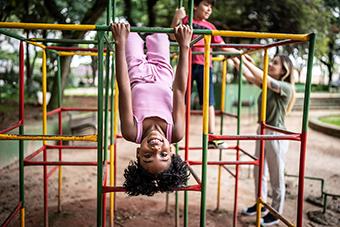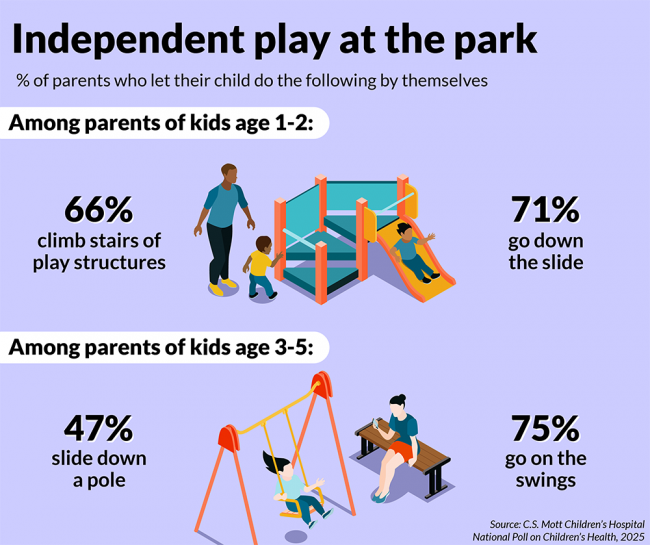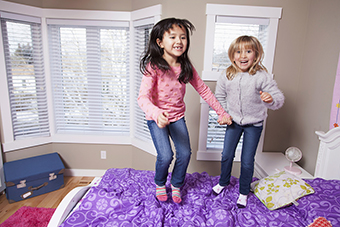Parent perspectives on play


Parent perspectives on play
Children need to develop a range of skills that support their physical, mental, emotional and social development. Play is the main way that young children develop these skills. The C.S. Mott Children’s Hospital National Poll on Children’s Health asked a national sample of parents of children 1-5 years about how their child plays.
In describing how their child plays on a typical day at home, 88% of parents say their child is very likely to engage in physical play like running, jumping or climbing; 68% make-believe or pretend play; 54% object play such as puzzles or blocks; and 31% video games or other media play. Most parents report that on a typical day at home their child will look at or listen to books (65%) and watch TV or videos (60%).
Most parents of children 3-5 years (78%) and nearly half of parents of children 1-2 years (47%) describe situations where they encourage or allow their child to play games on a phone or tablet. Common situations are to keep their child occupied while parents are doing something else (44% parents of children 3-5 years vs 24% parents of children 1-2 years), in the car (41% vs 21%), to keep their child quiet in public places (34% vs 21%), or whenever their child asks (12% vs 5%).
Most parents say their child plays outside almost every day (62%) or a few times a week (29%), but 9% say their child plays outside once a week or less. In describing their child’s independence when playing outside, most parents of 1- to 2-year-olds let their child climb up the stairs of a play structure (66%) or go down the slide (71%) by themselves. Parents of 3- to 5-year-olds say their child goes on the swings (75%), slides down the pole of a play structure (47%) or crosses the monkey bars (41%) by themselves. Half of parents (51%) strongly agree that it’s healthy for children to take risks when they play; these parents are more likely to report their child engages in these activities independently.
When their child tries a new physical challenge when playing, 48% of parents say they hold their child’s hand and/or stand right next to them. This is more common among the 41% of parents who report feeling nervous when their child goes too far or too high.

Highlights
- 2 in 3 parents say their young child has pretend play on a typical day.
- 1 in 10 parents say their young child plays outside once a week or less.
- 4 in 10 parents say they get nervous when their child goes too far or too high when playing.
Implications
To a young child, it’s fun to run, build a tower with blocks, or pretend to bake a cake. But parents should realize that important things happen while children play. Findings from this Mott Poll suggest that parents can do more to facilitate their child’s growth and development through a wide range of play.
Play is the key to how young children learn and develop. It starts in infancy, with parents playing peekaboo. As children become toddlers and then preschoolers, they create their own version of play. Play can happen anytime and anywhere; with toys or with everyday household objects; alone, with parents, or with other children.
Different types of play contribute to different aspects of a child’s development. Physical play promotes the development of gross motor skills, coordination, and muscle growth, and is part of a healthy lifestyle. Pretend or make-believe play stimulates creativity, language development, emotional development, and executive function. Object play, where children manipulate blocks, puzzles, or other items, helps children practice fine motor skills and promotes cognitive development such as problem-solving, critical thinking, and understanding cause and effect.
In this Mott Poll, most parents reported their toddler or preschooler is very likely to engage in physical play on a typical day, but less likely to have pretend play or object play. This doesn’t mean that parents should force their child to play in a certain way; play should be enjoyable and mostly child-directed, not dictated by parents. However, parents can encourage different types of play by providing a variety of toys or household items that young children can use for make-believe or object play.
Playing outside has been shown to improve children’s physical and mental health; it also contributes to good eye health and supports an appreciation of nature. However, nearly 1 in 10 parents in this Mott Poll reported their young child plays outside once a week or less often. Parents should look for opportunities to be outside with their children multiple times a week, even if just for short periods.
Being outside also provides opportunities for risky play. Risky play can be any independent activity that allows the child to push their own boundaries, such as exploring a different area of the play structure, climbing a tree, riding a bike, or running down a hill. For young children, risky play boosts confidence and self-esteem, and helps develop problem solving and risk assessment. However, it can be hard for parents to appreciate these benefits when they are anxious about their child getting hurt. While this is understandable, prohibiting a child from risky play, or insisting on holding their hand throughout, impedes that child’s development. Instead, parents should allow space for children to test their own limits, figure out what strategies work, and feel a sense of accomplishment. Parents can be available but not hurried in offering assistance from a safe distance.
Sometimes parents push children to play “the correct way” by using a toy or object the way it was intended. However, children learn from exploring what happens when things are done differently. Though they can’t articulate it verbally, a child may wonder what would happen if they tried to climb up the slide or put a ball on top of the tower of blocks; play allows them to find out. Allowing children to take the lead on how they play, rather than insisting that there is a “correct way” to play, provides the space for them to learn.
This Mott Poll shows that most parents of preschoolers, and nearly half of parents of toddlers, use their cell phone or a tablet to keep their young child occupied and quiet in public places, in the car, or while the parent is occupied. For parents, a cell phone is readily available, easy to hand to the child, and often effective in keeping the child occupied. And while some video games may offer some educational benefits, parents generally should limit the amount of time their young child spends in media play and be prepared to encourage other types of play when possible.

Data Source & Methods
This report presents findings from a nationally representative household survey conducted exclusively by Ipsos Public Affairs, LLC (Ipsos) for C.S. Mott Children’s Hospital. The survey was administered in August 2025 to a randomly selected, stratified group of adults who were parents of at least one child age 1-17 years living in their household (n=2,029). Adults were selected from Ipsos’s web-enabled KnowledgePanel® that closely resembles the U.S. population. The sample was subsequently weighted to reflect population figures from the Census Bureau. The survey completion rate was 66% among panel members contacted to participate. This report is based on responses from 710 parents with at least one child age 1-5. The margin of error for results presented in this report is ±2 to 7 percentage points.
Findings from the C.S. Mott Children’s Hospital National Poll on Children’s Health do not represent the opinions of the University of Michigan. The University of Michigan reserves all rights over this material.
Citation
Clark SJ, Gebremariam A, Schultz SL, Frisk C, Woolford SJ. Parent perspectives on play. C.S. Mott Children's Hospital National Poll on Children's Health, University of Michigan. Vol 48, Issue 2, October 2025. Available at: https://mottpoll.org/reports/parent-perspectives-play.


